Trees
Tree description⚑
Alder⚑
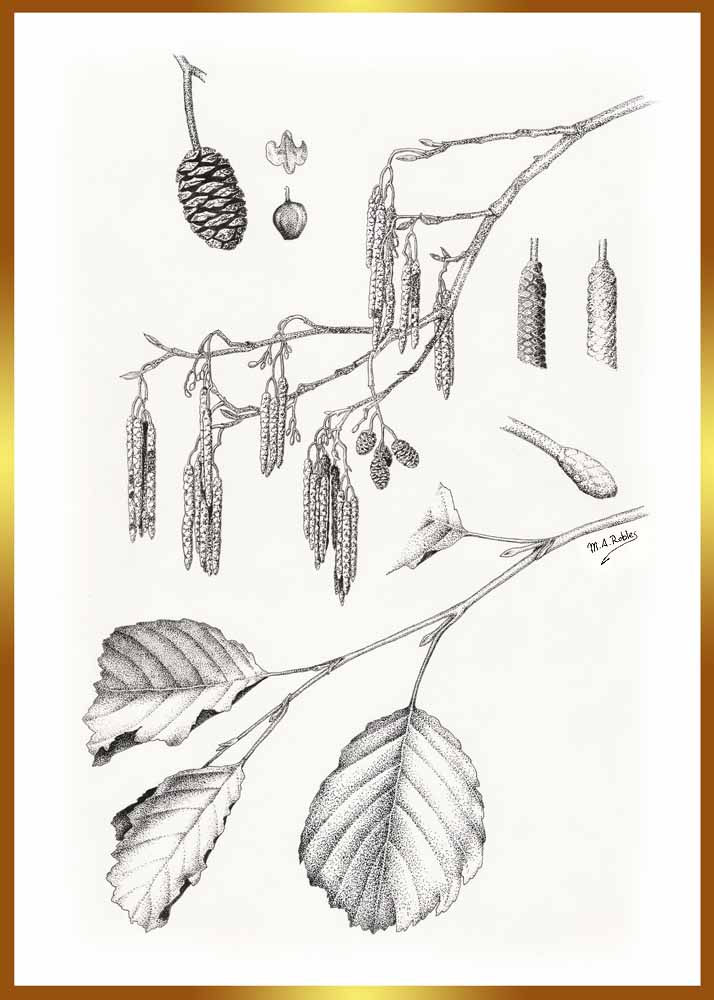
Alders are trees comprising the genus Alnus in the birch family Betulaceae (like the birch). The genus parts are "al" which means "close by" and "lan" which means "side of the river", so they are trees that grow close to rivers or creeks.
With a few exceptions, alders are deciduous, and the leaves are alternate, simple, and serrated. The flowers are catkins with elongate male catkins on the same plant as shorter female catkins, often before leaves appear; they are mainly wind-pollinated, but also visited by bees to a small extent. These trees differ from the birches (Betula, another genus in the family) in that the female catkins are woody and do not disintegrate at maturity, opening to release the seeds in a similar manner to many conifer cones.
The largest species are red alder (A. rubra) on the west coast of North America, and black alder (A. glutinosa), native to most of Europe and widely introduced elsewhere, they are usually are between 17 and 22m with a diameter not greater than half a meter. Although in some areas of europe they rarely go over 10 or 12 meters. Exceptionally they have reached over 30 metres and 3 of diameter. By contrast, the widespread Alnus alnobetula (green alder) is rarely more than a 5 m-tall shrub.
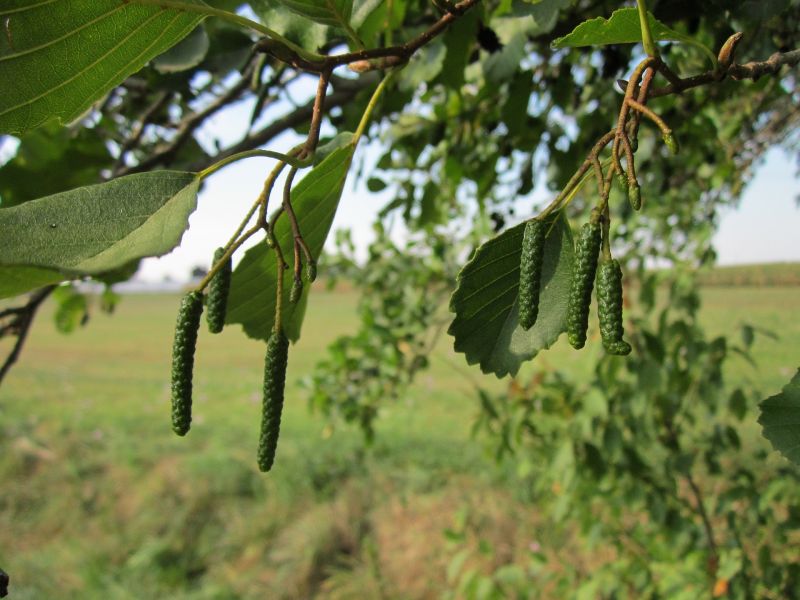
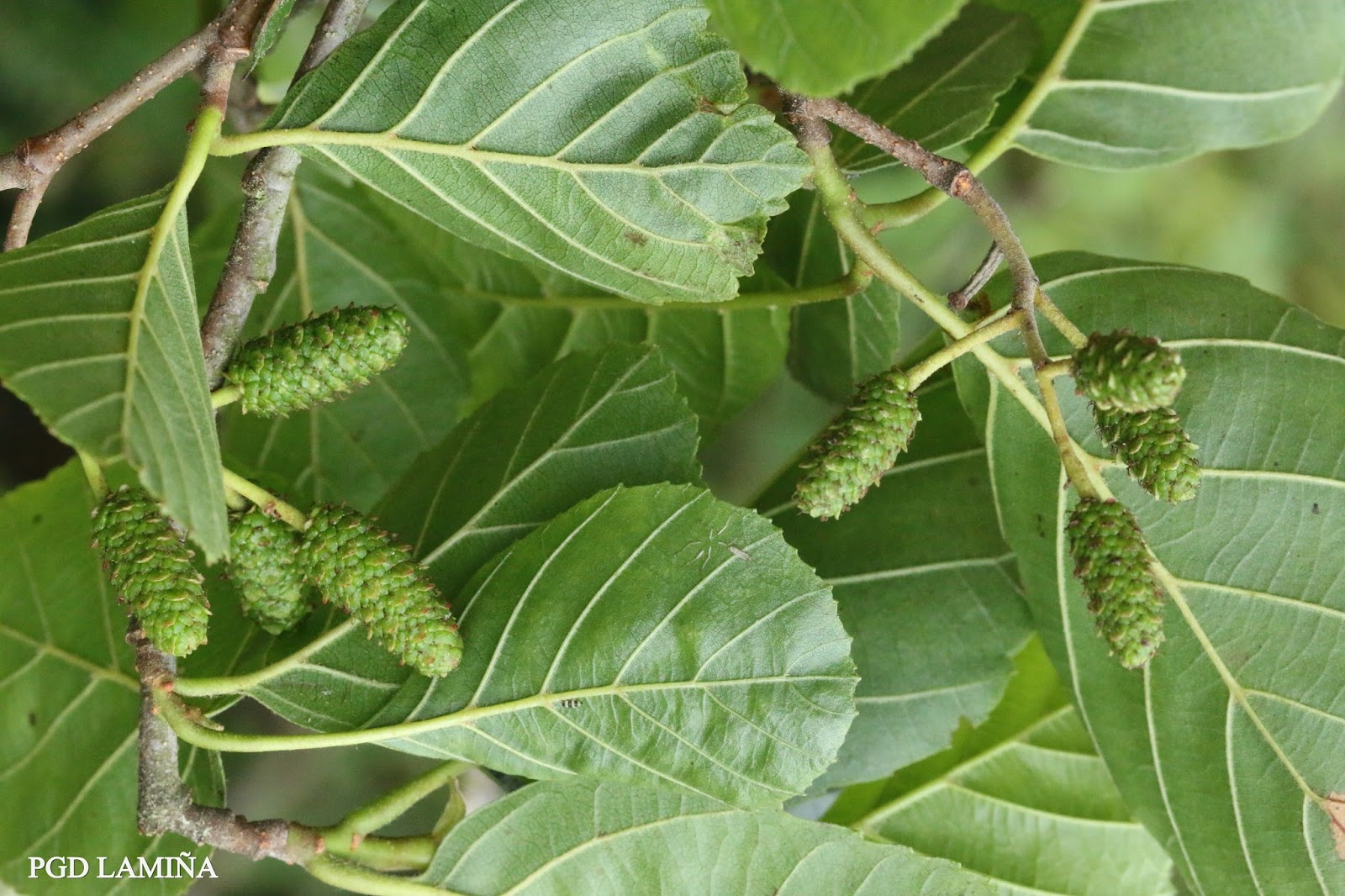
Their leaves are rounded, sparsely toothed, symmetric or slightly asymmetric at the base, green on both sides. They reach the 12cm long and have a short petiole. Even though they are deciduous, the leaves stay green until they fall. The black alder (alnus glutinosa) has sticky leaves.
The bearing or appearance of the alder varies with the age. When it's young it has a regular canopy, pyramidal or pointed. Once it gets older the ramification is more irregular and divided making a dense canopy that gives a lot of shadow. It's not very long-lived, it usually lives around a hundred years.
The trunk is cylindrical, right and quite clean. it's bark is always thin, in the young one is is smooth, shiny and greenish brown. The older ones is longitudinally cracked, scaled and of dark colour.
Their roots have a peculiarity, they have some knots of different centimeters wide where some fungi associated to the tree live.
Below there are some guides to differentiate it from the beech and the birch
Ash⚑
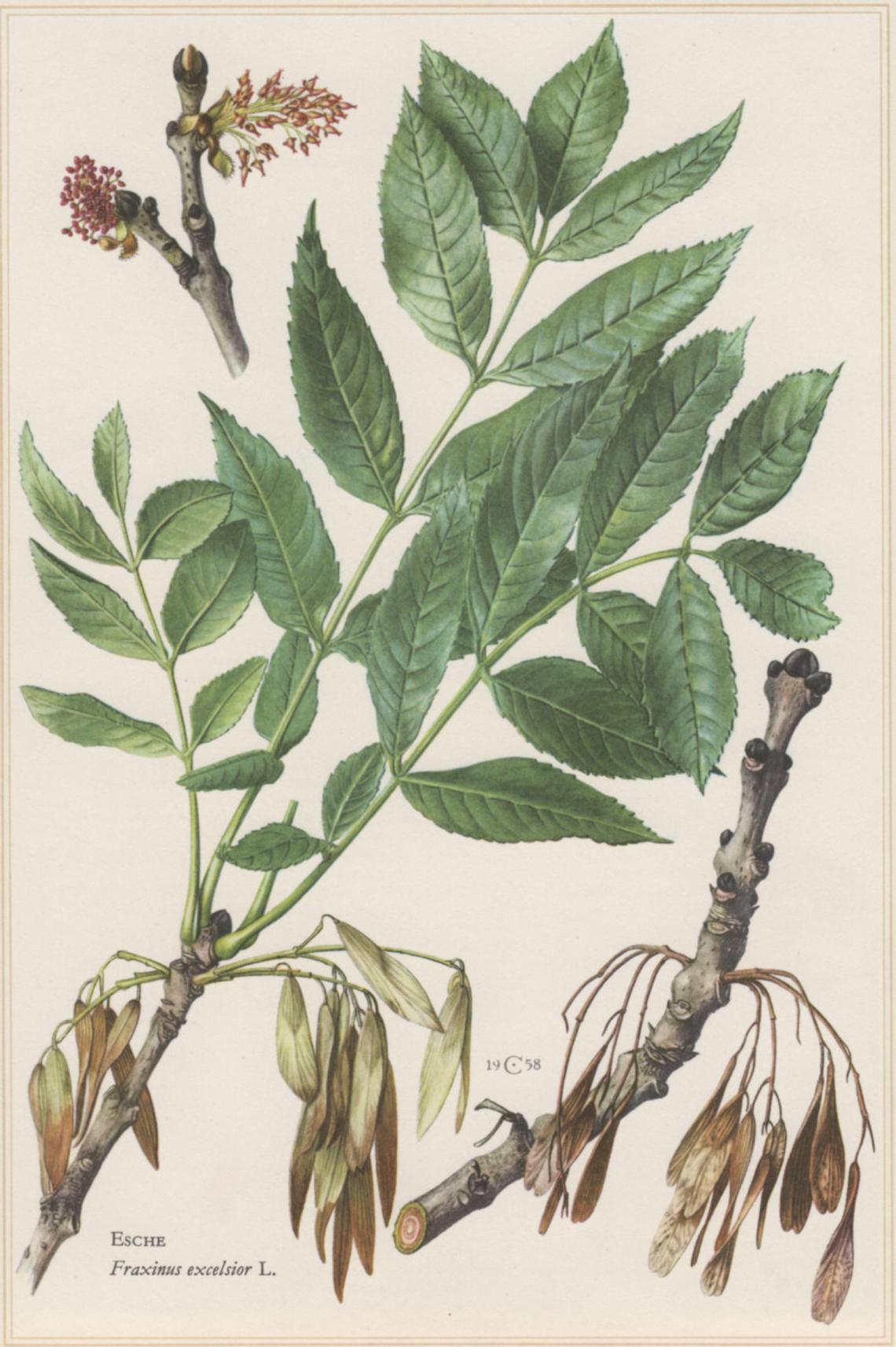
Beech⚑
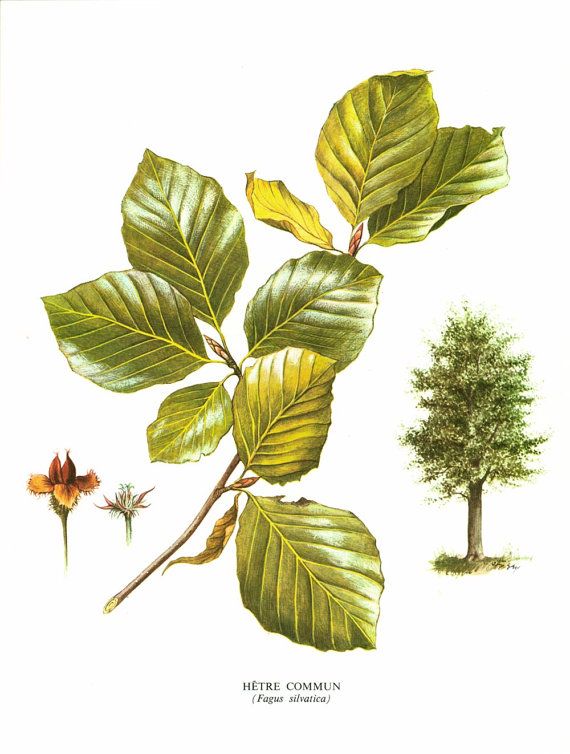
Beech (Fagus sylvatica) is a genus of deciduous trees in the family Fagaceae, native to temperate Europe, Asia, and North America. The better known Fagus subgenus beeches are high-branching with tall, stout trunks and smooth silver-grey bark. Fagus comes from the greek word "phegos" which means edible. "Sylvatica" refers to form forests.
Beeches are monoecious, bearing both male and female flowers on the same plant. The small flowers are unisexual, the female flowers borne in pairs, the male flowers wind-pollinating catkins. They are produced in spring shortly after the new leaves appear. The fruit of the beech tree, known as beechnuts or mast, is found in small burrs that drop from the tree in autumn. They are small, roughly triangular and edible, with a bitter, astringent, or in some cases, mild and nut-like taste. They have a high enough fat content that they can be pressed for edible oil.
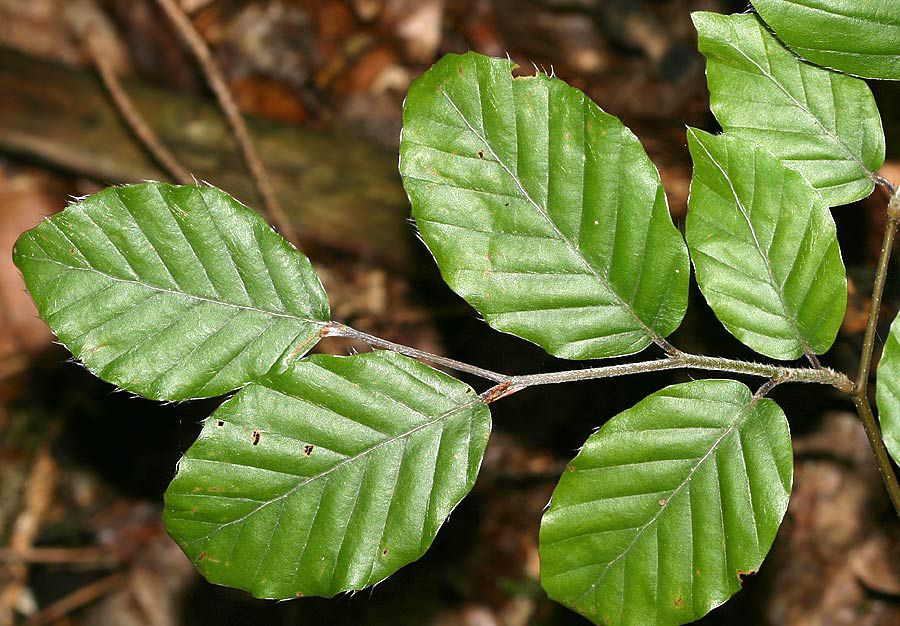
The leaves of beech trees are elliptic, a little pointy at the end, flat, and with a short petiole. They are big and wide leaves ranging from 4-9 cm long. Very abundant, they have a light green colour with a darker tone and glossy on the upper side.
The fruit is a small, sharply three-angled nut 10-15 mm long, borne singly or in pairs in soft-spined husks 1.5-2.5 cm long, known as cupules. The husk can have a variety of spine- to scale-like appendages, the character of which is, in addition to leaf shape, one of the primary ways beeches are differentiated. The nuts are edible, though bitter (though not nearly as bitter as acorns) with a high tannin content, and are called beechnuts or beechmast.
They are big trees easily going between 30 and 45 meters. It looks very different if its isolated or being part of a forest. The first one the branches grow from the middle of the trunk and are horizontal, in the second, the branches go up and start over the half of the trunk. The principal root is very powerful, with very strong secondary roots, developing lateral superficial roots.
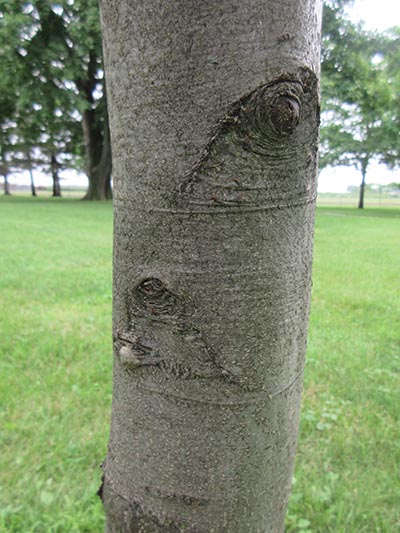
The trunk is right with a grayish-cinder bark, smooth until it's old, usually covered by moss an lichen. Smaller branches are zigzagging with reddish-brown pointy buds.
The canopy is big, dense, rounded and semi spheric, giving a lot of shadow.
It grows slow in the first years, being the most active between the tenth and twelve year, reaching it's maximum height when it's twenty five, although it lives around three hundred years.
Below there are some guides to differentiate it from the alder and the birch
Birch⚑
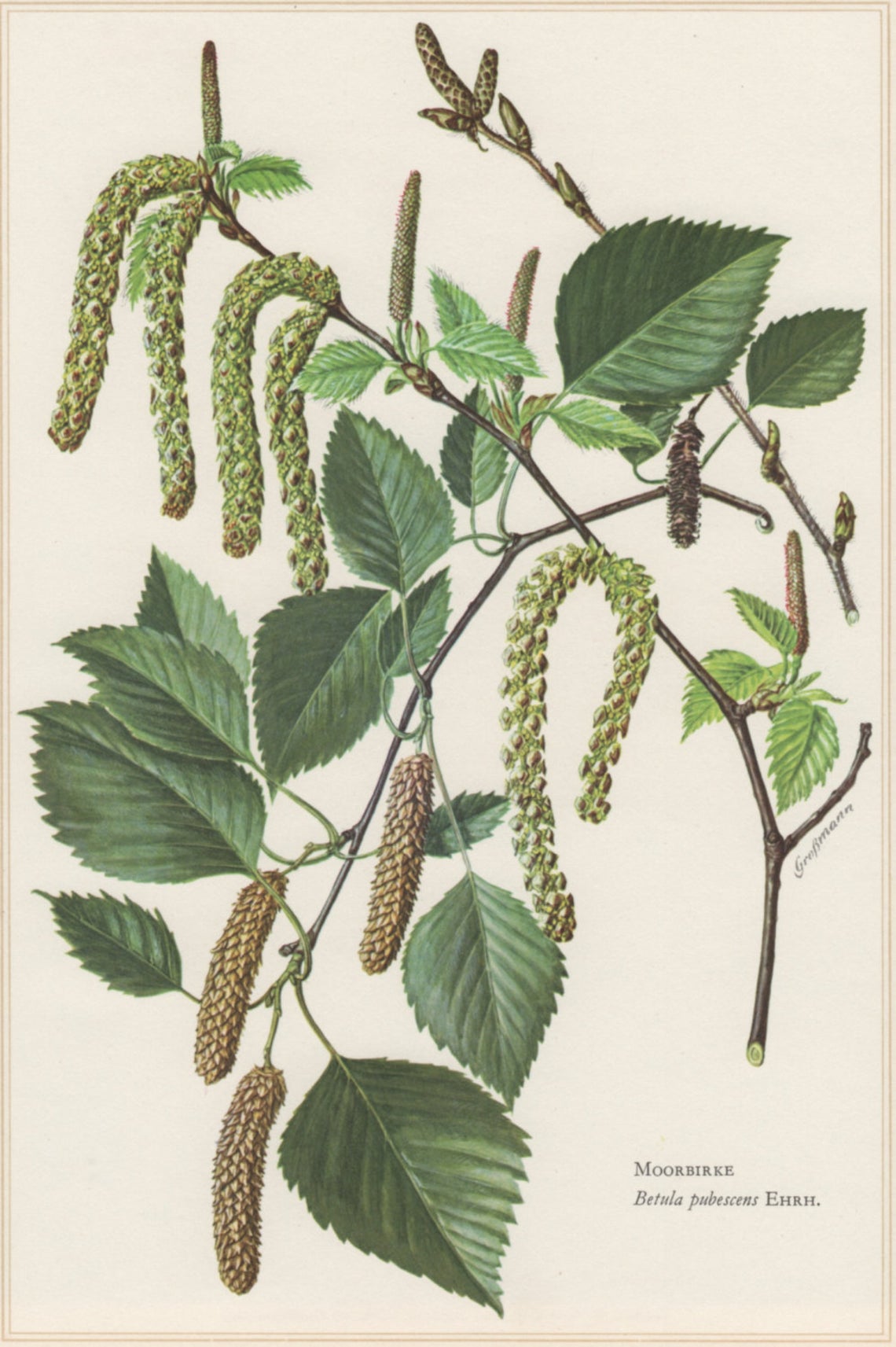
A birch is a thin-leaved deciduous hardwood tree of the genus Betula, in the family Betulaceae, which also includes alders, hazels, and hornbeams. It is closely related to the beech-oak family Fagaceae. They are a typically rather short-lived pioneer species.
Birch species are generally small to medium-sized trees or shrubs, mostly of northern temperate and boreal climates. They usually grow together close to each other with heights between 10 and 15 meters.
The simple leaves are rhomboidal, between 3 and 6 cm, singly or doubly serrate except at the base, feather-veined, petiolate and stipulate. Although they are alternate, many leaves spawn from each side of the branch, making some think that they are not alternate. They often appear in pairs, but these pairs are really borne on spur-like, two-leaved, lateral branchlets.
The canopy is rounded and irregular giving few shadow.
The fruit is a small samara, although the wings may be obscure in some species. They differ from the alders in that the female catkins are not woody and disintegrate at maturity, falling apart to release the seeds, unlike the woody, cone-like female alder catkins.
The bark of all birches is characteristically smooth and white, although in older ones the lower part is usually cracked and takes blackish brown colours. It's marked with long, horizontal lenticels, and often separates into thin, papery plates, especially upon the paper birch.
The buds form early and are full grown by midsummer, all are lateral, no terminal bud is formed; the branch is prolonged by the upper lateral bud. The wood of all the species is close-grained with a satiny texture and capable of taking a fine polish; its fuel value is fair.
Below there are some guides to differentiate it from the alder and the birch
How to tell apart the different trees⚑
Alder vs Beech⚑
| Property | Beech | Alder |
|---|---|---|
| Leaf border | flat | sparsely toothed |
| Leaf form | elliptic | rounded |
| Same colour both sides | no (darker and glossy up) | yes |
| Sticky leafs | no | yes |
| Size | 30-45m | 10-12m (in Europe) |
| Knots on the roots with fungi | no | yes |
| Where they grow | everywhere | close to rivers or creeks |
Alder vs Birch⚑
| Property | Birch | Alder |
|---|---|---|
| Leaf border | heavy toothed | sparsely toothed |
| Leaf form | rhomboidal | rounded |
| Sticky leafs | no | yes |
| Where they grow | very close to each other | close to rivers or creeks |
Beech vs Birch⚑
| Property | Beech | Birch |
|---|---|---|
| Leaf border | flat | heavy toothed |
| Leaf form | elliptic | rhomboidal |
| Size | 30-45m | 10-15m (in Europe) |
| Same colour both sides | no (darker and glossy up) | yes |
| Where they grow | everywhere | very close to each other |